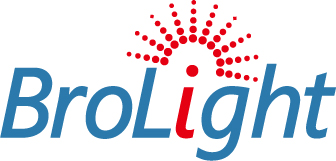Design and develop instruments and equipment for teaching and training purposes in universities, middle schools, primary schools, and vocational colleges, covering subjects such as physics, chemistry, biology, automation, robotics, LiDAR, surveying, computer science, automotive engineering,ultrasonic technology in medicine, physics and materials science etc.
Brolight- Science teaching Apparatus
Brolight design and manufacturer various science teaching and training instruments for physics and photonics majors. Brolight’s products are based on the basic concept of "hands-on science". Through modular design and sensor based data acquisition technology, better ways are used to help teachers and students complete experimental courses learning.
PASCO- Hands-on science education tools and datalogging solutions
PASCO's product line covers Physics (Mechanics, Thermodynamics, Optics, Electronics, Magnetism, Wave Theory, Atomics), Chemistry, Biology, Environment, Geography, Engineering, and more. Suitable for science experiments in primary, middle, and high schools, as well as basic physics/biochemistry in universities. It can be used for group experiments or independent open design innovation. It can also be used as a demonstration experiment in class and is compatible with international school AP, IB, and STEM experimental courses.
Matrix- Educational Engineering Training Solutions
Matrix provide industrial standard training equipment to education and training providers around the world. Our solutions cover science, engineering and technology disciplines from physics to robotics to microcontrollers, electrical installation, automotive and more.
GAMPT- Ultrasound Technology Experimental Kit
Based on many years of experience in supporting students in the widest variety of subject areas in physics practical work, we develop and produce equipment and experimental sets, with which clearly demonstrative training can be carried out in practical applications of ultrasonic technology in medicine, physics and materials science.
FESTO Didactic-Technical Education
Festo Didactic is the world-leading provider in the field of technical education. As a global partner for educational institutions, governments, state organizations and companies around the world, we design and implement training centers and laboratories, educational equipment and programs that train people to perform in highly dynamic and complex environments.
Brolight- Science Education Apparatus
Brolight was founded in 2012, Hangzhou, China.
Brolight is a professional provider of Science Education Apparatus & Photonics Instrument. We design and manufacture various experimental teaching and training kits for Physics and Photonics Majors, and we also provide the light analysis solutions base on Spectrum & light power intensity,to bring customers the high-quality, affordable, and reliable products.
Brolight design and manufacturer various science teaching and training instruments for physics and photonics majors. Brolight’s products are based on the basic concept of "hands-on science". Through modular design and sensor based data acquisition technology, better ways are used to help teachers and students complete experimental courses learning.
Science Education product line including:
- Modern physics - Photoelectric Effect, Hall Effect, Zeeman Effect, Electron To Mass Ratio apparatus, Nuclear Magnetic Resonance, Thermal Radiation
- Photonics - Laser principle, LED Characteristic analysis, Laser Scanner, iToF/Phase Shift Light Speed measurement, LiDAR principle
About PASCO
Students need modern tools and technology to succeed in STEM. At PASCO, we have been creating and manufacturing award-winning, hands-on science education tools and datalogging solutions since 1964. With our unique blend of dedication and experience, we think no one combines innovative, easy-to-use products with world-class support like we do.
Our very first product, the PASCO Millikan Oil Drop Apparatus, set the bar for our company: to create innovative products that exceed existing offerings or that are completely new to the marketplace. We continually strive to accomplish that goal, while helping educators stretch their budgets as far as possible, without compromising quality.
For the first few decades, our focus was on first-rate physics apparatus, something that is still one of our hallmarks. PASCO remains the premier supplier of high quality apparatus for physics and engineering labs. Eventually we branched out, as we became one of the first companies to offer sensors, interfaces, and data collection and analysis software. From there our product line has continued to grow. Anywhere we see an opportunity to put modern tools in the hands of science educators and students, we develop the best products in the market to fit that need.
The drive to innovate continues today. When creating new products, our first questions are “How will this help teachers and students?” and “What makes this product different?” Our line of wireless sensors and the innovative Smart Cart, as well as our new interactive textbooks, continue our tradition of doing our best to serve science education.
PASCO's product line covers Mechanics, Thermodynamics, Optics, Electronics, Magnetism, Wave Theory, Atomics, Chemistry, Biology, Environment, Geography, Engineering, and more. Suitable for science experiments in primary, middle, and high schools, as well as basic physics/biochemistry in universities. It can be used for group experiments or independent open design innovation. It can also be used as a demonstration experiment in class and is compatible with international school AP, IB, and STEM experimental courses.
Products:
For more than 55 years, we have been working with educators to provide cutting-edge educational tools that engage students in active learning. When you choose PASCO products, you enter a partnership complete with free online teacher support, webinars, and curricular solutions. In this fast-paced market, educational trends come and go, but PASCO remains dedicated to providing engaging and effective tools designed by educators for educators.

Signature and Featured Products
Our team of educators, scientists, and engineers consistently collaborate to provide you with products that are user-friendly, effective, and affordable. These products engage students in active learning to facilitate the development of critical thinking skills, design thinking, and science literacy.
- ● Signature Products - 850/550 interface, Wireless Diffraction System, Smart Cart….
- ● Complete Experiments- Mechanics,Fluids,Rotation,Structures,Materials,Thermodynamics,Electromagnetism,Waves & Optics,Quantum
- ● New Products- 850 Expansion Board,Motorized Crane,Motorized Drawbridge,StructureBOT,Photosynthesis Chamber,Melt Point Apparatus
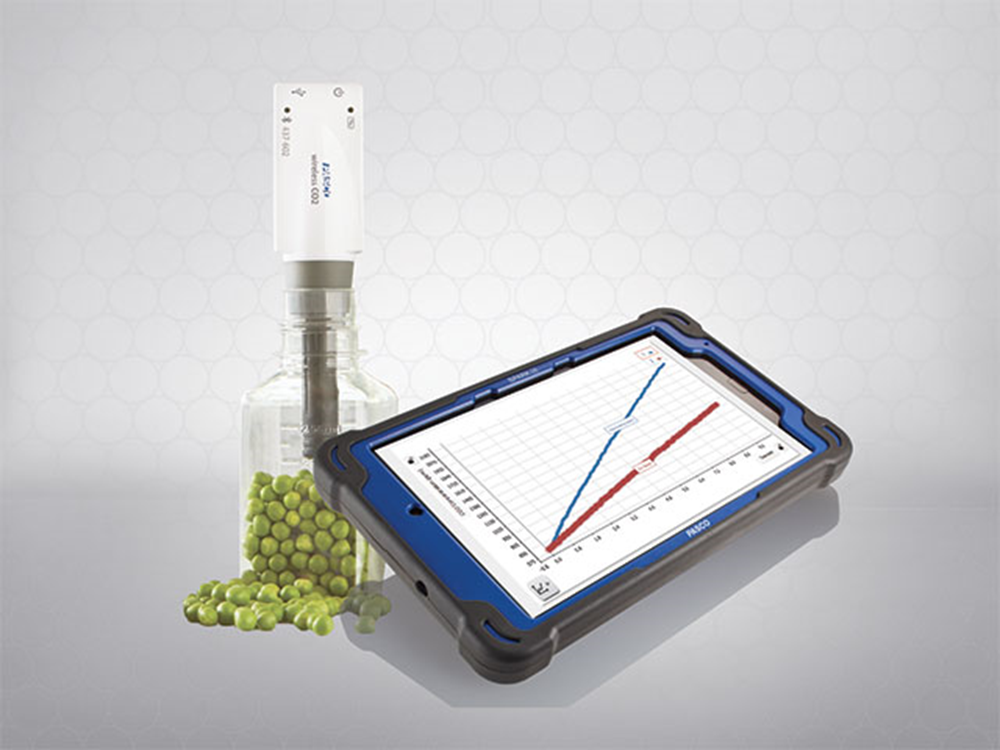
Sensors and Datalogging
We work with educators to develop user-friendly sensors, software, interfaces, and dataloggers that effectively eliminate manual data recording to facilitate quality scientific analysis. Our products generate live, interactive data that shift the experimental focus to understanding concepts and developing in-depth analysis skills.
- Sensors- Almost all physical quantities, including Wireless and wired Passport series/Science Workshop series
- Interfaces/Dataloggers- 850,550,Airlink, Sparklink
- Data Analysis Software- Capstone, Sparkuve, Chemuve
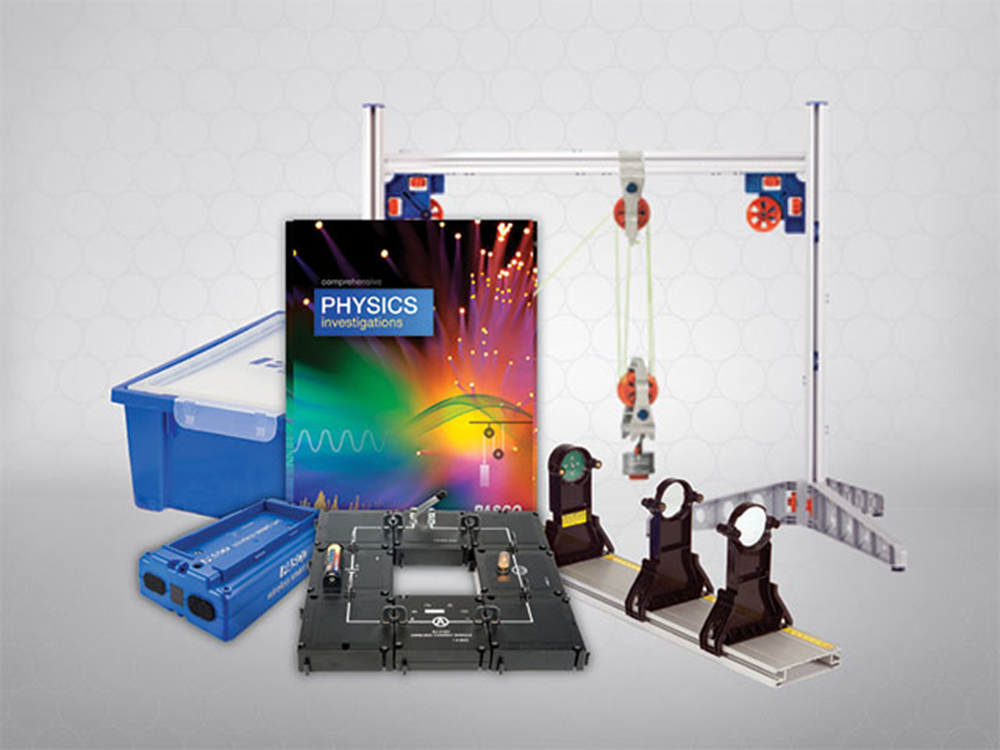
Curriculum and Bundles
PASCO offers two complete and affordable curriculum solutions: Essential Chemistry and Essential Physics. Both solutions include a Student Textbook, Student e-Book, Student Lab Manual, all-digital Teacher e-Resources, and Equipment. These modern STEM programs include a full year of instruction for both General, Honors, AP®, and IB® courses.
- Complete Curriculum
- PASCO Academy
- Equipment Kits & Bundles
- Lab Manuals & Teacher Guides

Lab Apparatus and Supplies
At PASCO, we love modernizing classic apparatus, creating groundbreaking demonstrations, and sometimes, just having fun. Whether you’re searching for supplies, such as clamps and glassware, or high-quality apparatus, like launchers and cloud chambers, we’re sure to have a PASCO engineered solution for you.
- Lab Apparatus
- Lab Supplies
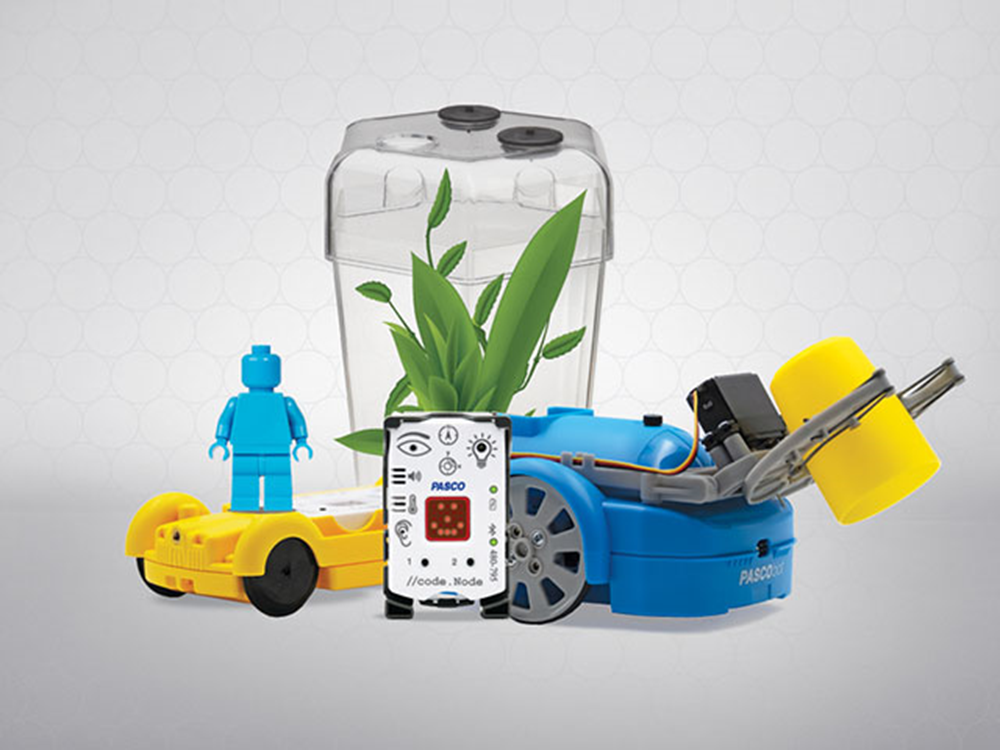
STEM Sense Solutions
STEM Sense solutions help build early excellence in science and STEM education with cross-curricular investigations that empower young learners to build strong foundations in science, programming, and data literacy.
- Coding with Sensors
- Sense & Control
- Build Your Own
About Matrix
Matrix is a provider of educational engineering training solutions- a premier supplier of products for education and development,Who develop, create and manufacture solutions which include full and comprehensive curriculum for multiple engineering disciplines.
Matrix solutions are created with students in mind, to ensure each aspiring engineer has access to hands on learning, on industrial standard equipment.
Matrix aspire to make hands on, comprehensive engineering teaching available to all students/young engineers worldwide.
Product for Solutions
We provide industrial standard training equipment to education and training providers around the world. Our solutions cover science, engineering and technology disciplines from physics to robotics to microcontrollers, electrical installation, automotive and more.
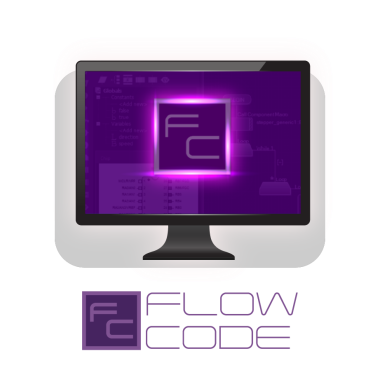
Flowcode allows students to develop highly functional electrical, electronic and electromechanical systems for embedded microcontroller-based systems. It is used to support learning in a range of technical disciplines throughout the world in schools (14+), colleges and universities.
Within the Education sector Flowcode is used in 7 separate disciplines:
- ● Embedded Software Development
- ● Electrical / Electronic Test
- ● Robotics & Mechatronics
- ● Automotive Engineering
- ● Embedded Music Technology
- ● Digital Signal Processing (DSP)
- ● Communications

The E-blocks2 system is ideal for everyone, from those learning in an educational environment to engineers in the industrial world. Use of E-blocks is well supported with complementary ranges of software (including PIC, dsPIC, ARM and AVR Arduino IDE, Flowcode), and support for Grove® sensors. Technical support is available from our dedicated team through our forums.
- ● Flexibility through modular design
- ● Small and compact solution
- ● Rugged and long lasting
- ● Seeed® Grove module compatible
- ● In-Circuit Test & Debugging
- ● Integration with Flowcode IDE
- ● Integration with Arduino
- ● Power routed through connectors
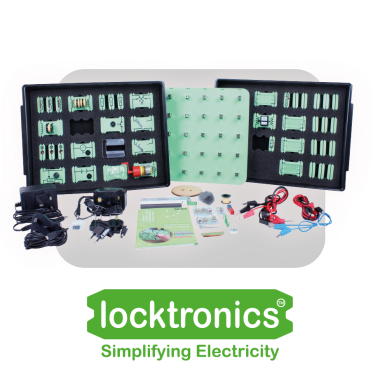
Locktronics is a range of products that simplifies the process of learning and teaching electricity and electronics. The core range consists of more than 200 electronic components ⟨ANSI and DIN⟩ mounted on rugged plastic carriers which are printed with the corresponding circuit symbol. Students use the carriers, in conjunction with a baseboard with interconnecting metal pillars to build up a working circuit, then use the worksheets provided to carry out experiments. All solutions are provided in sturdy storage solutions and with up to date curriculum always available online. Solutions are designed to be used 1 kit between 2 students. A demo panel is also available.
The Locktronics range helps students of many disciplines to apply electrical theory to electrical practice. The Locktronics range is used by thousands of educational institutions and training organisations across the world for electrical training, from primary school students through to automotive apprentices and trainee aviation maintenance engineers.
There are over 40 different curriculum packs available for the Locktronics range covering a wide spectrum of topics: from simple electricity for wiring technicians, through to advanced transistor characteristics for undergraduate electronic engineers. Curriculum consists of a number of worksheets and experiments, as well as lesson plans and teachers’ notes.
Our range of solutions are divided into 9 main subject areas: physics, basic engineering, computer science, aviation, automotive, robotics & mechatronics, electrical installation, electronic engineering and electrical installation. The solutions can also be used to provide a core of essential components which can be expanded with more specialist parts once the basic principles have been mastered.

The automatics Smart Factory allows students to get the experience of a number of processes and technologies commonly used in manufacturing and modern-day industry 4.0 principles. This includes conveyor systems, sensing systems, pneumatic pick and place technology, DC motor drivers and stepper motor drivers. The factory includes coloured discs made from plastic and other materials. A conveyor belt moves these pieces into the factory, where user programmed sensors sort the discs into multiple rejection bins. Some are picked off the conveyor by a suction device and a stepper motor controlled gantry sorts the discs into appropriately coloured containers. The smart factory is completely self contained and can be stored away in one of our standard trays. The smart factory can be used with Siemens (or other brand) 12V or 24V PLC.
Learning Objectives
- ● Factory control and automation systems
- ● Software design for automation
- ● DC motor and stepper drives
- ● Conveyor and gantry systems
- ● Vacuum pick and place systems
- ● Component sensing and sorting
- ● System design with more than one controller.

AllCode is a new concept in programming. All our AllCode products are host independent, run on a powerful 16bit dsPIC microcontroller and can be used with just about any programming language, including Flowcode, MATLAB, LabVIEW, Python, App Inventor, Visual Basic/C#/C++ and more.
Both Formula AllCode and the Robot Arm production cell are provided with free curriculum, helping you to get the most out of your new robotics solution. These courses include a range of activities with varied levels of difficulty: from simple line following to maze solving with the Formula AllCode robot buggy, and API control to automatic pick and place with the AllCode Robot Arm production cell.
Program your AllCode device with:
- ● Flowcode
- ● Raspberry Pi
- ● Android & Apple
- ● MATLAB & LabVIEW
- ● Windows & OS X
- ● Visual Basic/C#/C++
AllCode is host independent and used with a variety of languages:
 |
 |
 |
 |
|||
 |
 |
 |
 |
|||
 |
 |
 |
 |

Our MicroCNC range of machines are low voltage, easy to store and cost-effective; allowing students to work in small groups to prototype their designs and learn key machining concepts. The robust range is a great introduction to manufacturing engineering principles.
Why Choose MicroCNC
- ● Compact and easily stored
- ● Designed for students to work in small groups
- ● Learn key principles of CNC machining and prototype easily
- ● 2-axis lathe and 3 and 4-axis milling machines
- ● Includes software to easily convert your CAD designs
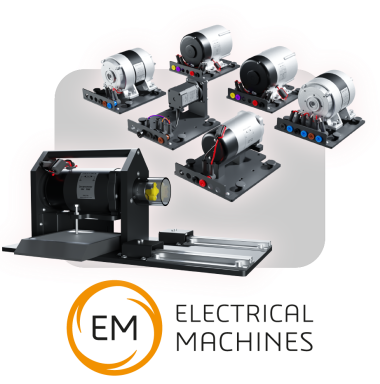
Modern electrical machines training system is a revolutionary way of safely studying the characteristics of different motor types in a learning environment. This solution includes ten different types of machine, integrated power supply and control box and PC-based applications for advanced controller of the different machine types. Further to this, we provide four separate curriculum manuals for teaching electrical machines principles using manual control with external meters, using PC control and also control using MATLAB.
Main Features
- ● Safe Operation; all moving parts covered
- ● Operates on 24V power, AC or DC
- ● Use manual or full PC Controls for the motors
- ● Measure voltage, current and power in DC and AC
- ● All machines are small footprint and low power
- ● Equipment can be easily stored and packed away

The Process Control training system from Matrix, is an innovative way of studying this commonly taught engineering subject. Controlled, portable and safe, these kits allow students to effectively investigate the principles of industrial process control, using independent Temperature, Pressure, Flow and Level based training systems.
System Benefits
- ● Rugged metal work which stands up to an educational setting
- ● USB, WiFi, Bluetooth and LAN connections
- ● Full free curriculum
- ● Remote connection capability
- ● Three different software options
- ● MATLAB / Lab view compatibility
- ● Small footprint, allows for easy classroom learning and storage
Learning objectives/experiments:
- ● Drive systems and their scaling factors
- ● Sensor characteristics, scaling factors, calibration
- ● Valve characteristics and calibration
- ● On/off control systems, oscillation, hysteresis
- ● System time constants
- ● P control systems and offset error
- ● PI control systems
- ● PID control systems
- ● Control functions and block diagrams
- ● Pseudocode implementations of P, PI and PID systems
- ● Recognition of problems in PID systems
- ● Integral wind up issues and overcoming them
- ● Derivative filtering
- ● Ziegler Nichols algorithm
- ● Manual tuning of PID systems

Automatics is a range of products that simplifies the process of teaching and learning about pneumatic and automation systems. The Automatics range has been designed to suit the classroom environment. The pneumatic components are identical to those used by real engineers, but have been cleverly adapted so that students can construct automation systems speedily and without tools. There are around 30 separate rugged components in the range, each one mounted on a clear acrylic carrier which is marked with the appropriate pneumatic or electrical symbol. Students mount the components on to the stable aluminium platform using plastic ‘tee’ bolts and connect the components together with nylon tubing to build working pneumatic circuits.
Why Choose Automatics:
- ● Makes learning easier
- ● Rugged and reliable
- ● Integrate Pneumatics & Control
- ● Covers a range of subject areas
- ● Extensive free curriculum
- ● Range of individual components
- ● Sturdy storage for solutions
- ● Minimal assembly required

The Structures range from Matrix, covers the seven commonly taught principles of structures, in the mechanical engineering subject area. Our solutions are suitable for colleges and universities worldwide.
The Structures range teaches students about Bending moments, Shear Force, Reactions of a simply supported beam, Bending Stress, Deflection of Beams, Torsion of rods and Pin jointed frameworks.
Main Features:
- ● Robust metal work panels, with removable legs for easy storage
- ● Carry handle with specially moulded cover to protect equipment when not in use
- ● Rugged and tough components designed to stand up to use in an educational lab
- ● USB connection, for easy power with simultaneous data collection and analysis
- ● Wall plug included with kits having built in LCD for manual data collection
- ● Comprehensive free curriculum and worksheets included with all 7 kits
Learning objectives/experiments:
- ● Bending Moments
- ● Bending Stress
- ● Deflection of Beams
- ● Simply Supported Beams
- ● Shear Force
- ● Pin Jointed Frameworks
- ● Torsion of Rods
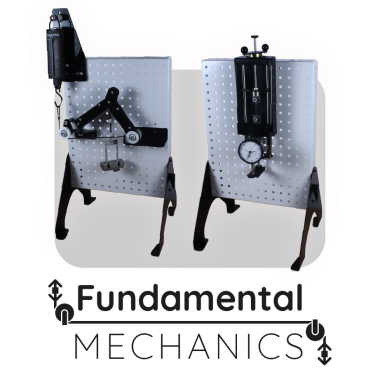
The fundamental mechanics range of equipment that allows students to study the principles of mechanical engineering required in many engineering related courses. Four kits are available in the main fundamentals range, covering statics, materials, dynamics and mechanisms fundamentals, meaning students can study a total of 21 experiments. A complete set combines all four in to one easy to use, robust and storable education system.
Further to these kits, we have also introduced kits for Linear and Rotational Dynamics with data-logging and Thermodynamics principles.
The curriculum range including:
- ● Statics
- ● Materials
- ● Dynamics
- ● Thermodynamics
- ● Linear and Rotational Dynamics
- ● Mechanisms

The study of fluid mechanics and the forces on them is becoming increasingly popular. With applications in a wide range of disciplines, including mechanical, civil, chemical and biomedical engineering, the Fundamental Fluids range from Matrix allows students to gain a hands on understanding of the key principles. A main workstation is supplied along with sixteen individual components, which allows students to build nine different experiments without the need for any additional tools. Six of the experiments are connected via USB to the pressure and flow sensors, which allows results to be automatically plotted on a graph for analysis. The remaining three experiments are carried out and plotted manually.
Each component is attached to the main workstation with quick release latches, allowing students to quickly build and dismantle each experiment. A full free curriculum is provided with easy to follow worksheets.
System Benefits
- ● Rugged metalwork which stands up to an educational setting
- ● Full curriculum available online free from Matrix
- ● Space saving solution with easily stored components
- ● Controller and Calibration apps available free
- ● One kit provides nine individual experiments
- ● Hoses with robust rubber gaskets allow reliable sealing
Learning Objectives/Experiments:
- ● Calibration of a bourdon gauge
- ● Centre of pressure on a partially and fully submerged plane
- ● Viscosity apparatus, demonstrating Stoke’s law
- ● Use of manometers and different types (multitube manometer, U-tube manometer and inclined manometer)
- ● Bernoulli’s equation and using a Venturi tube as a flow meter
- ● Losses in bends, measuring and comparing pressure losses of different bend geometries
- ● Centrifugal pump characteristics, experimentally determining the pressure/flow rate characteristics of a pump and determining the overall efficiency
- ● Series pumps, experimentally determining the pressure/flow characteristics of 2 pumps connected in series configuration
- ● Parallel pumps, experimentally determining the pressure/flow characteristics of 2 pumps connected in parallel configuration

The Matrix Electronic Flight Information System consists of an EFIS with LCD display, user controls, compass sensor, altitude sensor and a Locktronics board with additional potentiometers mimicking further sensors on an aircraft.
The sensors and the EFIS are connected with CAN bus. Students use this system and PC based diagnostic software to understand how complex computer based flight systems are made from separate electronic modules linked by multiplexed signals on a serial data bus – in this case the CAN bus. Fault finding with multi meters and oscilloscopes is included.
Features Including:
- ● Sensors and EFIS connected with CAN bus
- ● Fault finding with Multi meters and oscilloscope included
- ● Remote data acquisition and digital displaying of fault codes
- ● LCD displays and user control
- ● Wide curriculum coverage
- ● Flexibility of teaching space
- ● PC based diagnostic software
Learning Objectives/Experiments:
- ● Hexadecimal, decimal and binary number systems
- ● Message multiplexing
- ● Interconnection of electronics modules in aircraft systems
- ● Sensors in aircraft
- ● CAN/ARINC 825 bus systems in aircraft
- ● CAN/ARINC 825 bus fault-finding with a multimeter
- ● CAN/ARINC 825 bus fault-finding with an oscilloscope
- ● Built-in test, monitoring and fault-finding
- ● Fly-by-wire systems
- ● CAN bus message structure and protocol
- ● Electronic Flight Information Systems
- ● PC-based diagnosis software tools
- ● Use of GPS.
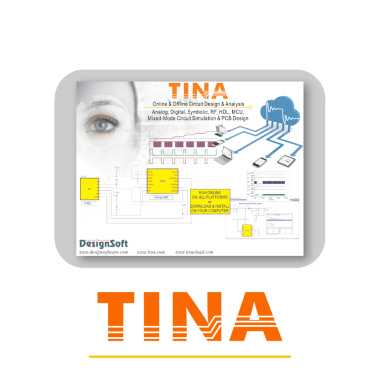
TINA is a powerful electronics CAD system for electronic product development including full schematic capture, many simulation tools, and a full circuit board layout package. TINA is used by thousands of professional designers across the world - including Texas Instruments who recommend TINA for simulating their analogue devices.
Electrical engineers will find TINA an easy to use, high performance tool, while educators will welcome its unique features for the training environment.
Learning Objectives:
- ● Schematic entry with more than 20,000 component models
- ● A mixed signal circuit simulation
- ● Full simulation suite with virtual instruments
- ● PCB design with full data output for PCB manufacture and 3D visualisation
- ● Microcontroller circuit simulator and debug facilities from Assembler or C
- ● VHDL and Verilog design suite with simulation
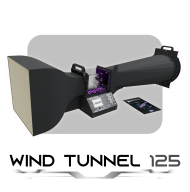
This compact open circuit sub-sonic wind tunnel training equipment is designed for benchtop use.
The wind tunnel is designed for teaching aerodynamic principles and exploration of fluid flow. Suitable for college to undergraduate teaching, it features a computer controlled fan, data acquisition and multiple experimental setups, controlled by a touch screen interface and also includes LED flow visualisation.
The wind tunnel has a 125mm transparent test section and 25m/s wind speed.
The wind tunnel has a honeycomb structure built into the contraction nozzle (ratio 9.2:1) which ensures uniform flow through the test section. The clear test section allows for visibility and clear understanding of the experimental behaviour. The air exits through a variable speed controlled fan, with a finger guard covering the back.
Built in data acquisition allows users to have direct output of pressure readings from pitot static tube and pressure tapping's. It also allows for real time lift and drag force components to be logged. Different drag shapes are provided along with multiple NACA profile aerofoils. Simple thread attachment allows students to design their own test pieces for analysis.
A smoke generator (provided) can be used to create streamline smoke trails over the test objects for visualisation of flow patterns.
The wind tunnel teaches many aerodynamic principles such as:
- ● Bernoulli’s equation
- ● Air flow over aerofoils
- ● Air flows around blunt and streamlined shapes
- ● Pressure distribution around a cylinder and aerofoil.
- ● Lift and drag forces for blunt and streamlined shapes
- ● Flow visualisation
- ● Manometers
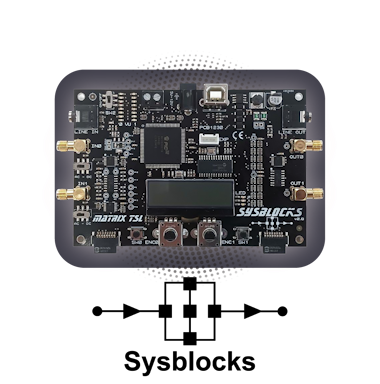
Together with Flowcode, Sysblocks provides a new way of teaching about signal processing for music technology, digital signal processing (DSP), communications and digital radio techniques.
Using a high speed, high power, 32bit PICmicro micro controller running at 200MHz, we are able to offer a comprehensive way of learning that is both cost and size effective for a classroom environment.
Sysblocks has four analogue inputs, two analogue outputs and support circuitry. The 32 bit PICmicro microcontroller is programmed by a host device which is a standard 18 series PICmicro microcontroller. This host device takes care of non-core tasks like USB communications, LCD display, encoder and switch inputs. This architecture keeps the main 32bit device free for signal processing.
Two E-blocks ports are made available for expansion. E-block boards for Wifi, keypad, Bluetooth, CAN, Zigbee and many other functions are available, along with a Grove connector, giving huge flexibility. The analogue input signals are buffered and level shifted to half of the supply voltage – 1.65V – and then fed to the internal A to D converters of the main 32 bit PICmicro microcontroller.
A digital potentiometer allows the level of the input signals to be adjusted in software. The board is fitted with a number of switches and encoders for control purposes. The board also has a miniature monochrome graphical display and a number of programmable LEDs including 2 x 8 LED VU meter LEDs. The board is powered from 3.3V from USB or from a plug top power supply.
![]()
Founded in 1998 by employees of the Institut für Medizinische Physik und Biophysik of Martin Luther University Halle-Wittenberg, the name GAMPT – Company for Applied Medical Physics and Technique – now stands for comprehensive expertise in the field of ultrasonic measuring technology. We design our own projects and work together with partners from business and research to find solutions. A growing network of customers and partners in Germany, Europe, Asia and the USA is a reflection of many successful collaborations.
Top Products for Realistic Training
Based on many years of experience in supporting students in the widest variety of subject areas in physics practical work, we develop and produce equipment and experimental sets, with which clearly demonstrative training can be carried out in practical applications of ultrasonic technology in medicine, physics and materials science.
GMAPT’s Experimental Sets include(PHY=Physics, IND=Industry, MED=Medicine):
Basics of ultrasound
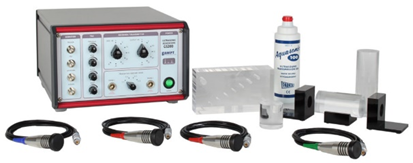
Exploring fundamental physical-technical principles of ultrasound technology and its application in medicine, natural and engineering science
Experiments:
- ● PHY01 Basics of pulse echo method (A-scan)
- ● PHY02 Sound velocity in solids
- ● PHY06 Frequency dependence of resolution power
- ● PHY08 Ultrasonic B-scan
- ● IND01 Non-Destructive Testing (NDT)
- ● IND03 Level measurement
Ultrasound in medicine

Application of ultrasound technology in medical diagnostics, especially suitable for medical and medical-technical vocational training at colleges
Experiments:
- ● PHY01 Basics of pulse echo method (A-scan)
- ● PHY06 Frequency dependence of resolution power PHY08 Ultrasonic B-scan
- ● MED01 Ultrasonic TM-mode (echocardiography)
- ● MED02 Ultrasonic imaging at breast phantom (mammasonography)
- ● MED04 Biometry at the eye phantom
Ultrasound in material science and engineering
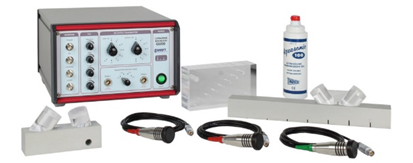
Non-destructive testing (NDT) by means of some of the most common ultrasound testing methods, such as the pulse-echo method and the through-transmission method, angle beam testing and the TOFD procedure using different material samples
Experiments:
- ● PHY01 Basics of pulse echo method (A-scan)
- ● PHY06 Frequency dependence of resolution power IND01 Non-Destructive Testing (NDT)
- ● IND03 Level measurement
- ● IND06 Angle beam testing
- ● IND07 Crack depth determination (TOFD)
Shear and surface acoustic waves
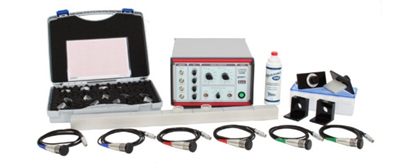
Investigating the mode transformation of ultrasonic waves at boundaries between liquids and solids and at boundaries of different solids as well as determination of sound velocity of shear and surface acoustic waves (Rayleigh and Lamb waves)
Experiments:
- ● PHY04 Acoustic attenuation in liquids
- ● PHY07 Shear waves in solids
- ● PHY23 Dispersion of ultrasonic waves (Lamb waves)
- ● IND02 Detection of cracks with Rayleigh waves
Debye-Sears effect
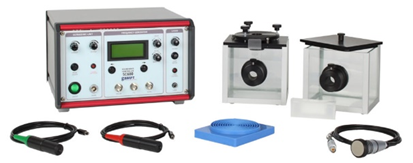
Introduction into acousto-optics and the use of continuously emitted ultrasonic waves with imaging of a standing ultrasonic wave field using laser light
Experiments:
- ● PHY11 Debye-Sears effect
- ● PHY12 Projection of standing waves
Ultrasonic Doppler effect
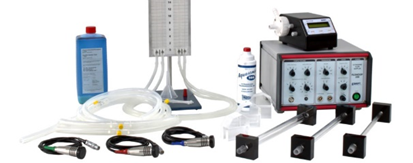
Investigating the essential dependences of the shift in Doppler frequency upon transmission frequency, incidence angle and flow velocity
Experiments:
- ● PHY13 Ultrasonic Doppler effect
- ● PHY15 Fluid mechanics
Doppler sonography

Investigating the fundamental physical dependences of ultrasonic Doppler effect on frequency, incidence angle and blood flow velocity
Experiments:
- ● PHY13 Ultrasonic Doppler effect
- ● MED03 Basics of Doppler sonography
- ● MED05 Vascular ultrasound (angiology)
Acousto-optical effects

Exploring interactions between a mechanical wave and light, also known as the acousto-optical effects (AOM, acousto-optical modulation)
Experiments:
- ● PHY11 Debye-Sears effect
- ● PHY17 Acousto-optical modulation at standing waves
- ● IND04 Concentration measurement with resonance cell
Ultrasonic CT and scanning methods

Comprehensive and clear introduction into structure and function of computer tomography measuring systems using ultrasound
Experiments:
- ● PHY08 Ultrasonic B-scan
- ● PHY09 Ultrasonic computer tomography (CT)
- ● PHY10 Characteristics of sound field
- ● PHY16 Mechanical scan methods
- ● PHY20 Determination of focus zone
Ultrasonic imaging

Examining the possibilities and limits of the B-scan method with vivid tracking of the individual steps from a single ultrasound signal to the complete B-scan image
Experiments:
- ● PHY01 Basics of pulse echo method (A-scan)
- ● PHY08 Ultrasonic B-scan
- ● MED07 Ultrasound test phantom
- ● MED08 Ultrasound fetal phantom
B-scan ultrasonography

Application-oriented investigation of possibilities and limitations of the B-scan technique and practice of fundamental
Experiments:
- MED08 Ultrasound fetal phantom
Festo, Established in 1925, the independent family-owned company based in Esslingen a.N., Germany. As a leading partner in global enterprises and educational institutions, Festo Didactic has been providing state-of-the-art education and training solutions to 56,000 industrial enterprises and educational institutions around the world since 1965, supporting 56,000 educational partners, universities, vocational colleges and industrial training centers worldwide with training on topics such as factory automation, electrical and electronic engineering, process control, Industry 4.0, smart manufacturing, building automation, new energy technology, etc., from basic courses to technical learning centers with turnkey teaching equipment and training solutions in more than 40 languages. In 1985, Festo Didactic started its business in China and has been deeply committed to the Chinese market, providing services in four business areas: dual-system teaching, vocational training, industrial training and consulting, and competition training and support for more than 600 enterprises, institutions, colleges, universities, vocational colleges and training bases.
Training solutions for technical education including:
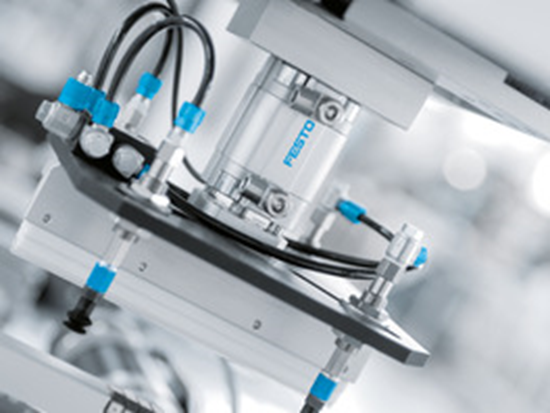 |
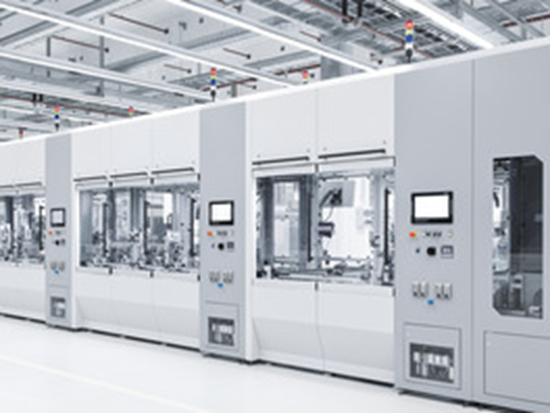 |
 |
||
| Pneumatics and Hydraulics | Industrial Automation and Industry 4.0 | Lernmaterial | ||
 |
 |
 |
||
| Electricity and Electronics | Process Automation | Electric Power Technology | ||
 |
 |
 |
||
| Communications and Radar Technology | Environmental Technology | Building System Technology | ||
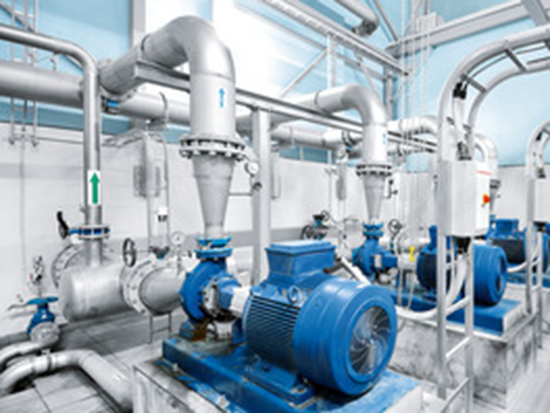 |
 |
 |
||
| Industrial Trades | Integrative STEM | Software | ||





